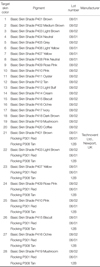1. Hickey AJ, Salter M. Prosthodontic and psychological factors in treating patients with congenital and craniofacial defects. J Prosthet Dent. 2006; 95:392–396.

2. Nemli SK, Aydin C, Yilmaz H, Bal BT, Arici YK. Quality of life of patients with implant-retained maxillofacial prostheses: a prospective and retrospective study. J Prosthet Dent. 2013; 109:44–52.

3. Andres CJ, Haug SP. Facial prosthesis fabrication: coloration techniques. In : Taylor TD, editor. Clinical maxillofacial prosthetics. Chicago IL: Quintessence Publishing Co, Inc;2000. p. 233–244.
4. Hu X, Johnston WM. Translucency estimation for thick pigmented maxillofacial elastomer. J Dent. 2011; 39:e2–e8.

5. Hungerford E, Beatty MW, Marx DB, Simetich B, Wee AG. Coverage error of commercial skin pigments as compared to human facial skin tones. J Dent. 2013; 41:986–991.

6. Johnston WM, Ma T, Kienle BH. Translucency parameter of colorants for maxillofacial prostheses. Int J Prosthodont. 1995; 8:79–86.
7. Coward TJ, Seelaus R, Li SY. Computerized color formulation for African-Canadian people requiring facial prostheses: a pilot study. J Prosthodont. 2008; 17:327–335.

8. Seelaus R, Coward TJ, Li S. Coloration of silicone prostheses: technology versus clinical perception. Is there a difference? Part 2, clinical evaluation of a pilot study. J Prosthodont. 2011; 20:67–73.

9. Xiao K, Zardawi F, van Noort R, Yates JM. Color reproduction for advanced manufacture of soft tissue prostheses. J Dent. 2013; 41:e15–e23.

10. Korfage A, Borsboomb PC, Dijkstra PU, van Oort RP. Analysis of translucency of skin by volume reflection for color formulation of facial prostheses. Int J Prosthodont. 2009; 22:623–629.
11. Nuseir A, Hatamleh M, Watson J, Al-Wahadni AM, Alzoubi F, Murad M. Improved construction of auricular prosthesis by digital technologies. J Craniofac Surg. 2015; 26:e502–e505.

12. Kiat-amnuay S, Johnston DA, Powers JM, Jacob RF. Color stability of dry earth pigmented maxillofacial silicone A-2186 subjected to microwave energy exposure. J Prosthodont. 2005; 14:91–96.

13. CIE Technical Report. Colorimetry. 3rd ed. Publication 15. Vienna: CIE Central Bureau;2004.
14. Cicchetti DV. Guidelines, criteria, and rules of thumb for evaluating normed and standardized assessment instruments in psychology. Psychol Assess. 1994; 6:284–290.

15. Paravina RD, Majkic G, Del Mar Perez M, Kiat-Amnuay S. Color difference thresholds of maxillofacial skin replications. J Prosthodont. 2009; 18:618–625.

16. Leow ME, Ow RK, Lee MH, Huak CY, Pho RW. Assessment of colour differences in silicone hand and digit prostheses: perceptible and acceptable thresholds for fair and dark skin shades. Prosthet Orthot Int. 2006; 30:5–16.
17. Wee AG, Lindsey DT, Shroyer KM, Johnston WM. Use of a porcelain color discrimination test to evaluate color difference formulas. J Prosthet Dent. 2007; 98:101–109.

18. Douglas RD, Steinhauer TJ, Wee AG. Intraoral determination of the tolerance of dentists for perceptibility and acceptability of shade mismatch. J Prosthet Dent. 2007; 97:200–208.

19. Ragain JC Jr, Johnston WM. Minimum color differences for discriminating mismatch between composite and tooth color. J Esthet Restor Dent. 2001; 13:41–48.

20. Ruyter IE, Nilner K, Moller B. Color stability of dental composite resin materials for crown and bridge veneers. Dent Mater. 1987; 3:246–251.

21. Douglas RD, Brewer JD. Acceptability of shade differences in metal ceramic crowns. J Prosthet Dent. 1998; 79:254–260.

22. Melgosa M, Hita E, Perez MM, El Moraghi A. Sensitivity differences in chroma, hue, and lightness from several classical threshold datasets. Color Res Appl. 1995; 20:220–225.

23. Dawson JB, Barker DJ, Ellis DJ, Grassam E, Cotterill JA, Fisher GW, Feather JW. A theoretical and experimental study of light absorption and scattering by in vivo skin. Phys Med Biol. 1980; 25:695–709.

24. Ishikawa-Nagai S, Ishibashi K, Tsuruta O, Weber HP. Reproducibility of tooth color gradation using a computer color-matching technique applied to ceramic restorations. J Prosthet Dent. 2005; 93:129–137.

25. Xiao K, Zardawi F, Van Noort R, Yates JM. Developing a 3D colour image reproduction system for additive manufacturing of facial prostheses. Int J Adv Manuf Technol. 2014; 70:2043–2049.

26. Hatamleh MM, Watts DC. Porosity and color of maxillofacial silicone elastomer. J Prosthodont. 2011; 20:60–66.











 PDF
PDF ePub
ePub Citation
Citation Print
Print




 XML Download
XML Download